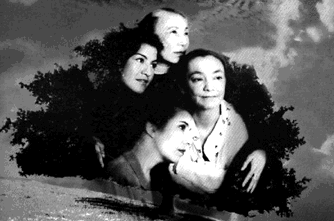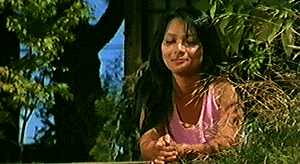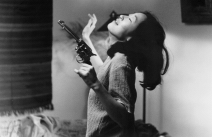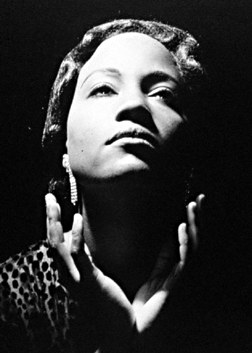This is a lighthearted, very personal look at the meaning of cultural identity. As a Lumbee Indian, the filmmaker is constantly confronted with the fact that she does not fit any of society's stereotypes for Native Americans. Those stereotypes are im posed by both whites and other Indians, alienating the filmmaker from many of the conventional notions of Native American identity. Real Indian is a unique look into the fascinating and complex world of Lumbee Indian culture and makes viewers ques tion perceptions of Native Americans as well as the meaning of their own cultural identity.

Looks into the Night is a short drama which powerfully portrays the moving story of Laura, a medical school student in Los Angeles, of Chumash Tribal descent. Separated from her family and culture as a child, she experiences disturbing dreams a nd visions which propel her on a journey of self-discovery. Through a twist of events, she is reunited with her family and culture where she learns "We're never alone, not ever!" It will be screened with Follow Your Dreams, a half-hour documentar y talk show which addresses the issues raised in Looks into the Night.
Song Journey takes Arlene Bowman (Navajo) on the pow-wow circuit in the hope of reviving her connection to traditional Native culture. There she finds a fascinating movement amongst Native American female musicians who are both carrying forwar d the musical traditions of the First Nations as well as conducting an effective rebellion against the male monopoly of the "inner circle" represented by the drum. Song Journey is a powerful illustration of the strength of contemporary Native cult ural identity.
Drawing from memory and narrative, Via New York explores the politicization of African students in New York and the participation of South African lesbians and gays in the anti-apartheid movement of the 1980s.
A picture of an unknown Tajik woman found in a Russian book on Tajikistan encourages videomaker Mehrnaz Saeed-Vafa to reflect on issues of exile and cultural conflict for Muslim women from Afghanistan and Iran living in the United States. Moving inter views with four women (including the director's mother) are interwoven with personal observations, images of the Tajik woman and fascinating footage of Iran and Muslim culture in the US. A Tajik Woman touches on many issues familiar to Muslim immi grants: war and revolution, loss of homeland and conflict with fundamentalist Islamic values.
Kumbharwada, Bombay captures the spirit of life in a potters' colony in Dharavi, Asia's largest slum. These rural Gujarati potters came to settle in Bombay a century ago. Despite their everyday hardships, Kumbharwada not only survives, it thri ves. In Hindi and Gujarati with English subtitles.

Portraying the Vietnamese immigrant experience through Kieu, A Tale of Love follows the quest of a woman in love with "Love." The film is loosely inspired by "The Tale of Kieu," the Vietnamese national poem of love which Vietnamese people see a s a mythical biography of their "motherland," marked by internal turbulence and foreign domination. A free-lance writer, Kieu also works as a model for a photographer who idealized the headless female body and who captures Kieu sheathed by transparent ve ils. Voyeurism runs through the history of love narratives and voyeurism is here one of the threads that structures the "narrative" of the film. Exposing the fiction of love in love stories and the process of consumption, A Tale of Love marginali zes traditional narrative conventions and opens a denaturalized space of acting where performed reality, memory and dream constantly pass into one another. A Tale of Love eloquently evokes an understanding of the allusive and powerful connections between love, sensuality, voyeurism and identity.
"A search for a non-existent image, a desire to create an image where there is none" gives rise to Rea Tajiri's composition on recorded history and non-recorded memory. Framed by the ever-present and haunting facts of the post-Pearl Harbor Japanese in ternment camps, which dislocated 120,000 Japanese-Americans during World War II, Tajiri creates a version of her family's story through interviews and historical detail, remembering a time that many people, including the artist's mother, would rather forg et. Throughout, this video surveys the impact of images (real images, desired images made real, and unrealized dream images) on our lives, drawing from a variety of sources such as Hollywood, U.S. Dept. of Defense films, newsreels, memories of the living , and spirits of the dead, as well as Tajiri's own intuitions of a place she has never visited but of which she has a memory. Relics of the camps, contrasted with human efforts to forget their existence, create a sense of taxonomic insistence that these camps were indeed real.
Jewela, the six year old protagonist of Firefly, is at odds with the world around her. She feels abandoned by her mother, who has left her with her grandmother, Sylvia. Jewela is rejected by her peers, and feels trapped in the staunch, cloiste red world of her grandmother. She draws pictures for consolation, and writes notes to herself which she tucks away in odd places, in the almost futile hope that someone else might find them. Through the course of the film, Sylvia comes to recognize some of her granddaughter's anguish and provides her with a key to their familial history. This allows Jewela to access a kindred soul, her ancestor Trinka, whose spirit travels through time.
Four diverse women of color tell the story of a poor, Black woman from East Oakland whose graduation from an elite university thrusts her into confrontation with loss, historical memory, and ambivalence. The main character, Linden M. Jordan, is perfor med by two African-American women, an Asian American woman, and a Puerto-Rican American woman. Each Linden misses a lover, Asani, in New York, and remembers one grandfather's life's work as a Pullman Porter on the Southern Pacific Railroad. His stories, laughter, and hopes for Linden's future, and her longing to be with Asani, are told with a mix of joy, sensuality, and rage.
They were leaders of the Young Lords, the militant Puerto Rican civil rights organization that rose up in New York City's barrio and galvanized a generation of political activists. Thirty years later, many are mainstream journalists and community lead ers. In Palante, Siempre Palante!: The Young Lords, Iris Morales makes history come alive as veterans of the movement recall their fight for equality, jobs, health care, and education.
Us Girls was produced in The Mirror Project, an alternative media project that educates inner-city teenagers in Somerville, Massachusetts. "Coming from ethnic, racial and social groups often marginalized in US history, these young producers doc ument their own sense of history straight from the source: themselves." Us Girls was shot in Somerville.
No Frontin focuses on the relationship of three young Puertorriquenas living in the Boston area, and the challenges they confront. This video was produced in South End, a predominantly Puerto Rican working-class neighborhood of Boston.
Twenty-Two is a seven minute narrative fiction about the coming out of a 22-year-old Latina gay female.
Filmed on location in East Austin, this film explores and bridges differences in the Black community. The relationship between two African-American women is explored and developed against a backdrop of community concern about the detriments of alcohol .
La Encrucijada (The Crossroads) is a short fictional film on the experiences of a woman crossing the Mexico/U.S. Border, her reasons for her actions and her eventual direction. The film depicts a moment in time, while examining the causes and r amifications of her decision through the juxtaposition of images representing memory, reality, and the border.

The morning after a break-in at her Korean immigrant father's convenience store, Il Bae, 20-something and strong-willed, catches a hunky shoplifter--only to discover he's a Native Canadian friend's brother to whom she's powerfully attracted. In the space of one day Il Bae's family routine collides with her New World romance, catching her between loyalty to her father and her passion for a new lover with a checkered past. Physical chemistry, cross-cultural confusions, racism, and the constant threat of u rban violence converge in this fast-paced, wryly humorous take-off on love at first sight where trust and desire strike a delicate balance.
Sheila and Rosi is a comedy about two sistas living hard in the city who do what they need to get by. The film illustrates that when you're not afraid of it, survival is sometimes the stuff of good times.
Badass Supermama is a playful, but questioning personal exploration of race, gender, sexuality, adolescent notions of beauty, body image and representation. These multi-layered, inter-connected issues are intimately examined through 1970s "blax poitation" movie goddess Pam Grier in Foxy Brown. The videomaker tries on the powerful badass supermama role of Foxy Brown while exploring the space between body and image. The lyrical video is gently critical, playing with the idea of masquerade as well as girlhood and adolescent fantasies of black womanhood.
This video is a celebration of unlimited sexuality, desires, strengths and dreams. The sacred roots in women of color branch out to the skies of endless strengths and beauty. Chinh phuc bang loi noi (conquer through voices).
Fulbeck force-feeds the viewer scores of all-too familiar Asian female/Caucasian male pairings in Hollywood movies and combines them with contemporary excerpts from novels, magazines, dating services, and anonymous pointed questions. Some Questions for 28 Kisses pries into the causes and purposes of these created images and their relation to interracial dating patterns, ethnic fetishes, race and gender wars, and hapa identity. The son of an Asian mother and Caucasian father, Fulbeck begins by q uestioning his own personal reactions to this media phenomena and its shifting intersection with real life.
Siren Spirits is a feature comprising four short dramas produced by the British Film Institute for BBC Television.
Ngozi Onwurah's White Men Are Cracking Up uses a murder mystery to explore the legacies of British colonialism and the exoticization of Black women.
Using magic realism, Memsahib Rita by Pratibha Parmar looks at the physical and emotional violence of racism. Shanti is haunted by both the racist taunts of nationalist white youths and the memory of her white mother.
Dani Williamson's Get Me to the Crematorium on Time is a moving portrait of undying love and grief. When her husband of twenty years dies, Bonetta is overcome by her loss and is taken to a mental hospital; but she knows she must escape to get t o the crematorium to say farewell to the man with whom she has shared her life.
In Frances-Anne Solomon's Bideshi a 50-year-old Bengali man lies in a coma in hospital, his soul stuck in a dark tunnel near death, until a resolution of his conflict with his daughter liberates his spirit.
Skeletons in the closet? Halving the Bones delivers a surprising twist to this tale. This film tells the story of Ruth, a half-Japanese filmmaker living in New York, she has inherited a can of bones that she keeps on a shelf in her closet. Th e bones are half of the remains of her dead Japanese grandmother, which she is supposed to deliver to her estranged mother. A narrative and visual web of family stories, home movies and documentary footage, Halving the Bones explores the meaning o f family, history and memory, cultural identity and what it means to have been named after Babe Ruth.
A documentary short about a Black feminist lesbian's exploration of her coming out process through self reflection and candid conversation with her father, brother, and best friend from high school.
This short documentary explores the complexity of mixed-race identity and the pressures to choose a particular racial community while feeling a part of more than one.

The Watermelon Woman, set in present day Philadelphia, is the story of Cheryl, a twentysomething black lesbian struggling to make a documentary about a beautiful and elusive 1930's film actress, popularly known as "The Watermelon Woman."
Cheryl is an aspiring filmmaker working "temporarily" (for the past two years) as a video store employee. With her best friend and co-worker, the quick-witted Tamara, she has concocted a way to order tapes on the sly for free. This seemingly innocent scam leads to all sorts of surprises: a love affair with a tony and very white customer, and an obsession with a little known black actress, Fae "The Watermelon Woman" Richards, who played mammy characters in the films of one of early Hollywood's only wo men directors, Martha Page.
Contact the Research Cluster for the Study of Women of Color